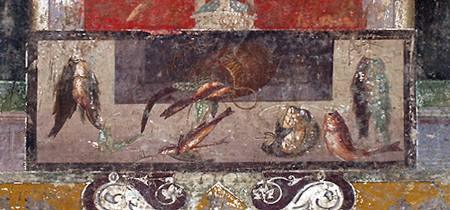 1
1The juxtaposition of ‘still-life’ vignette and entrance to a metaphysical world may well transform xenia into ex-voto. Hence signifying commemoration or worship through the giving of offerings to the implied divinity residing beyond the entrance. For example, the bronze tripod in the upper section of the wall-painting in the tablinum of the Casa di M. Lucretius Fronto could well suggest the presence of Apollo. In addition to being placed between two doors it is also located in front of a vignette depicting various types of fish (fig.1).
From illusion to allusion
In essence the evolution of Roman wall-painting is the transition from illusion to allusion – faux marble to conceptually coherent trompe l’oeil environments to metaphysical spaces. This paradigm shift was a major contribution to the history of painting and deceiving the eye was by no means its main raison d’être. It simply provided the strategy that enabled it to depict metaphysical worlds via an elaborate juxtaposition of physical and perspectival space. The spatial sophistication that it achieved is highlighted by the fact that the laws governing perspective appeared fourteen hundred years after the demise of Pompeii and Herculaneum. In modern terms their achievement equates to the transition between pictorial and computer generated virtual reality environments. And yet, many key publications on the history of perspective, excluding Richter, G., 1970, Perspective in Greek and Roman Art, ignored perspectival paintings such as these.
The Birth and Rebirth of Pictorial Space (White 1924) and The Origin of Perspective (Damisch 1999), both failed to acknowledge the remarkable perspectival sophistication displayed in Roman wall-painting. One wonders if this unwillingness was due to the fact that the paintings existed in domestic interiors and were, therefore, not considered to be high-art. White remedied his omission in 1956 with his publication Perspective in Ancient Drawing and Painting. Damisch’s omission is, in many respects, the more puzzling because his book was supposedly concerned with the “origin” of perspective, and much of it focuses on fifteenth-century Città ideale paintings, some of which have compositional and conceptual similarities to Second Style tholoi paintings (fig.2). Both use ‘font of life’ imagery in the form of the Baptistery and the tholos to create an optical-conceptual focal point. In terms of origins they represent an intriguing shift from pagan to Christian uses of symbolic perspective linked to divine worship.
|